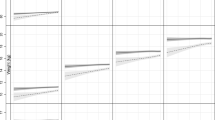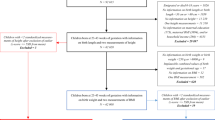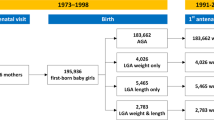Abstract
Objective
The objective of this study is to analyze the effect of adjusting for body measures on the association between small for gestational age (SGA) and overweight at 3 years.
Study design
Data were obtained from the Preterm Infant Multicenter Growth Study (n = 1089). Logistic regression was used, to adjust for confounders with additional adjustments separately for weight and height at 21 months. Marginal structural models (MSMs) estimated the direct effect of SGA on overweight.
Results
The crude and adjusted for confounders models yielded null associations between SGA and overweight. Adjusting for height yielded a positive association (odds ratio (OR): 2.31, 95% CI: 0.52–10.26) and adjusting for weight provided a significantly positive association (OR: 6.60, 95% CI: 1.10–37.14). The MSMs, with height and weight held constant, provided no evidence for a direct effect of SGA on overweight (OR: 0.83, 95% CI: 0.14–5.01, OR: 0.71, 95% CI: 0.18–2.81, respectively).
Conclusion
Adjusting for body measures can change the association between SGA and overweight, providing spurious estimates.
This is a preview of subscription content, access via your institution
Access options
Subscribe to this journal
Receive 12 print issues and online access
$259.00 per year
only $21.58 per issue
Buy this article
- Purchase on Springer Link
- Instant access to full article PDF
Prices may be subject to local taxes which are calculated during checkout
Similar content being viewed by others
References
Barker DJP. The origins of the developmental origins theory. J Intern Med. 2007;261:412–7. https://doi.org/10.1111/j.1365-2796.2007.01809.x.
Koletzko B, Brands B, Grote V, Kirchberg FF, Prell C, Rzehak P, et al. Long-term health impact of early nutrition: the power of programming. Ann Nutr Metab. 2017;70:161–9. https://doi.org/10.1159/000477781.
Crume TL, Scherzinger A, Stamm E, McDuffie R, Bischoff KJ, Hamman RF, et al. The long-term impact of intrauterine growth restriction in a diverse U.S. cohort of children: the EPOCH study. Obesity. 2014;22:608–15. https://doi.org/10.1002/oby.20565.
Barros FC, Victora CG. Increased blood pressure in adolescents who were small for gestational age at birth: a cohort study in Brazil. Int J Epidemiol. 1999;28:676–81. https://doi.org/10.1093/ije/28.4.676.
Kramer MS, Zhang X, Dahhou M, Yang S, Martin RM, Oken E, et al. Does fetal growth restriction cause later obesity? Pitfalls in analyzing causal mediators as confounders. Am J Epidemiol. 2017;185:585–90. https://doi.org/10.1093/aje/kww109.
Paneth N, Ahmed F, Stein AD. Early nutritional origins of hypertension: a hypothesis still lacking support. J Hypertens Suppl. 1996;14:S121–9.
Tu Y-K, West R, Ellison GTH, Gilthorpe MS. Why evidence for the fetal origins of adult disease might be a statistical artifact: the “Reversal Paradox” fOr the Relation between Birth Weight and Blood Pressure in Later Life. Am J Epidemiol. 2005;161:27–32. https://doi.org/10.1093/aje/kwi002.
Huxley R, Neil A, Collins R. Unravelling the fetal origins hypothesis: is there really an inverse association between birthweight and subsequent blood pressure? Lancet. 2002;360:659–65. https://doi.org/10.1016/S0140-6736(02)09834-3.
Lucas A, Fewtrell MS, Cole TJ. Fetal origins of adult disease-the hypothesis revisited. BMJ. 1999;319:245–9. https://doi.org/10.1136/bmj.319.7204.245.
Kramer MS. Invited commentary: association between restricted fetal growth and adult chronic disease: is it causal? Is it important? Am J Epidemiol. 2000;152:605–8. https://doi.org/10.1093/aje/152.7.605.
Doyle LW, Faber B, Callanan C, Morley R. Blood pressure in late adolescence and very low birth weight. Pediatrics. 2003;111:252–7. https://doi.org/10.1542/peds.111.2.252.
Euser AM, Finken MJJ, Keijzer-Veen MG, Hille ETM, Wit JM, Dekker FW, et al. Associations between prenatal and infancy weight gain and BMI, fat mass, and fat distribution in young adulthood: a prospective cohort study in males and females born very preterm. Am J Clin Nutr. 2005;81:480–7. https://doi.org/10.1093/ajcn.81.2.480.
Vasylyeva TL, Chennasamudram SP, Okogbo ME. Can we predict hypertension among preterm children? Clin Pediatr. 2011;50:936–42. https://doi.org/10.1177/0009922811409918.
Juonala M, Cheung MMH, Sabin MA, Burgner D, Skilton MR, Hutri-Kahonen N, et al. Effect of birth weight on life-course blood pressure levels among children born premature. J Hypertens. 2015;33:1542–8. https://doi.org/10.1097/HJH.0000000000000612.
Schisterman EF, Cole SR, Platt RW. Overadjustment bias and unnecessary adjustment in epidemiologic studies. Epidemiology. 2009;20:488–95. https://doi.org/10.1097/EDE.0b013e3181a819a1.
Rothman K, Greenland SLT. Validity in epidemiologic studies. In: Rothman K, Greenland S, Lash T, editors. Modern Epidemiology. 3rd ed. Philadelphia: Lippincott Williams and Wilkins; 2008.
Hernán MA, Robins JM. Casual Inference. 2019. https://www.hsph.harvard.edu/miguel-hernan/causal-inference-book. Accessed 22 Nov 2019.
Ananth CV, Schisterman EF. Confounding, causality, and confusion: the role of intermediate variables in interpreting observational studies in obstetrics. Am J Obstet Gynecol. 2017;217:167–75. https://doi.org/10.1016/j.ajog.2017.04.016.
Kramer MS, Chalmers B, Hodnett ED, Sevkovskaya Z, Dzikovich I, Shapiro S, et al. Promotion of breastfeeding intervention trial (PROBIT): a randomized trial in the Republic of Belarus. JAMA. 2001;285:413–20. https://doi.org/10.1001/jama.285.4.413.
World Health Organization. Preterm birth: key facts. 2018. https://www.who.int/news-room/fact-sheets/detail/preterm-birth. Accessed 27 Nov 2019.
Public Health Agency of Canada. Perinatal Health Indicators for Canada. 2017. https://www.canada.ca/en/public-health/services/injury-prevention/health-surveillance-epidemiology-division/maternal-infant-health/perinatal-health-indicators-2017.html. Accessed 26 Nov 2019.
Giuliani F, Ismail LC, Bertino E, Bhutta ZA, Ohuma EO, Rovelli I, et al. Monitoring postnatal growth of preterm infants: present and future. Am J Clin Nutr. 2016;103:635S–47S. https://doi.org/10.3945/ajcn.114.106310.
Arianas EA, Rankin KM, Norr KF, White-Traut RC. Maternal weight status and responsiveness to preterm infant behavioral cues during feeding. BMC Pregnancy Childbirth. 2017;17:113. https://doi.org/10.1186/s12884-017-1298-4.
Hack M, Schluchter M, Andreias L, Seunghee M, Taylor HG, Drotar D, et al. Change in prevalence of chronic conditions between childhood and adolescence among extremely low-birth-weight children. JAMA. 2011;306:394–401. https://doi.org/10.1001/jama.2011.1025.
Hack M, Schluchter M, Cartar L, Rahman M. Blood pressure among very low birth weight (<1.5 kg) young adults. Pediatr Res. 2005;58:677–84. https://doi.org/10.1203/01.PDR.0000180551.93470.56.
Rotteveel J, van Weissenbruch MM, Twisk JWR, Delemarre-Van de Waal HA. Infant and childhood growth patterns, insulin sensitivity, and blood pressure in prematurely born young adults. Pediatrics. 2008;122:313–21. https://doi.org/10.1542/peds.2007-2012.
Fenton TR, Nasser R, Eliasziw M, Kim JH, Bilan D, Sauve R. Validating the weight gain of preterm infants between the reference growth curve of the fetus and the term infant. BMC Pediatr. 2013;13:92. https://doi.org/10.1186/1471-2431-13-92.
Fenton TR, Kim JH. A systematic review and meta-analysis to revise the Fenton growth chart for preterm infants. BMC Pediatr. 2013;13:59 https://doi.org/10.1186/1471-2431-13-59.
Zeve D, Regelmann MO, Holzman IR, Rapaport R. Small at birth, but how small? The definition of SGA revisited. Horm Res Paediatr. 2016;86:357–60. https://doi.org/10.1159/000449275.
Wang Z, Sauve RS. Assessment of postneonatal growth in VLBW infants: selection of growth references and age adjustment for prematurity. Can J Public Heal. 1998;89:109–14. https://doi.org/10.1007/BF03404400.
World Health Organization. WHO Child Growth Standards, length/height-for-age, weight-for-age, weight-for-length, weight-for-height and body mass index-for-age, methods and development. 2006. https://www.who.int/childgrowth/standards/technical_report/en/. Accessed 14 Nov 2019.
Bandoli G, Palmsten K, Flores KF, Chambers CD. Constructing causal diagrams for common perinatal outcomes: benefits, limitations and motivating examples with maternal antidepressant use in pregnancy. Paediatr Perinat Epidemiol. 2016;30:521–8. https://doi.org/10.1111/ppe.12302.
Williams TC, Bach CC, Matthiesen NB, Henriksen TB, Gagliardi L. Directed acyclic graphs: a tool for causal studies in paediatrics. Pediatr Res. 2018;84:487–93. https://doi.org/10.1038/s41390-018-0071-3.
World Health Organization. Social determinants of health. 2018. https://www.who.int/social_determinants/sdh_definition/en/. Accessed 27 Mar 2020.
Magriplis E, Farajian P, Panagiotakos DB, Risvas G, Zampelas A. Maternal smoking and risk of obesity in school children: investigating early life theory from the GRECO study. Prev Med Rep. 2017;8:177–82. https://doi.org/10.1016/j.pmedr.2017.10.001.
Quelhas D, Kompala C, Wittenbrink B, Zhen Han, Parker M, Shapiro M, et al. The association between active tobacco use during pregnancy and growth outcomes of children under five years of age: a systematic review and meta-analysis. BMC Public Health. 2018;18:1372. https://doi.org/10.1186/s12889-018-6137-7.
Ruiz M, Goldblatt P, Morrison J, Kukla L, Svancara J, Riitta-Jarvelin M, et al. Mother’s education and the risk of preterm and small for gestational age birth: a DRIVERS meta-analysis of 12 European cohorts. J Epidemiol Community Health. 2015;69:826–33. https://doi.org/10.1136/jech-2014-205387.
Meng Y, Groth SW. Fathers count: the impact of paternal risk factors on birth outcomes. Matern Child Health J. 2018;22:401–8. https://doi.org/10.1007/s10995-017-2407-8.
Muthuri SK, Onywera VO, Tremblay MS, Brolyles ST, Chaput JP, Fogelholm M, et al. Relationships between parental education and overweight with childhood overweight and physical activity in 9–11 year old children: results from a 12-country study. PLoS ONE. 2016;11:e0147746. https://doi.org/10.1371/journal.pone.0147746.
Cole SR, Hernán MA. Constructing inverse probability weights for marginal structural models. Am J Epidemiol. 2008;168:656–64. https://doi.org/10.1093/aje/kwn164.
Robins JM, Hernán MA, Brumback B. Marginal structural models and causal inference in epidemiology. Epidemiology. 2000;11:550–60. https://doi.org/10.1097/00001648-200009000-00011.
VanderWeele TJ. Marginal structural models for the estimation of direct and indirect effects. Epidemiology. 2009;20:18–26. https://doi.org/10.1097/EDE.0b013e31818f69ce.
Huxley RR, Shiell AW, Law CM. The role of size at birth and postnatal catch-up growth in determining systolic blood pressure: a systematic review of the literature. J Hypertens. 2000;18:815–31. https://doi.org/10.1097/00004872-200018070-00002.
Forsum E, Eriksson B, Flinke E, Henriksson H, Henriksson P, Löf M. Fat and fat‐free mass of healthy Swedish children show tracking during early life, but there are differences. Acta Paediatr. 2019;108:1704–8. https://doi.org/10.1111/apa.14771.
Giannì ML, Roggero P, Piemontese P, Morlacchi L, Bracco B, Taroni F, et al. Boys who are born preterm show a relative lack of fat-free mass at 5 years of age compared to their peers. Acta Paediatr. 2015;104:e119–23. https://doi.org/10.1111/apa.12856.
Huke V, Rudloff S, Brugger M, Strauch K, Berthold LD, Landmann E. Prematurity is not associated with intra-abdominal adiposity in 5- to 7-year-old children. J Pediatr. 2013;163:1301–6. https://doi.org/10.1016/j.jpeds.2013.06.035.
Saigal S, Stoskopf B, Streiner D, Paneth N, Pinelli J, Boyle M. Growth trajectories of extremely low birth weight infants from birth to young adulthood: a longitudinal, population-based study. Pediatr Res. 2006;60:751–8. https://doi.org/10.1203/01.pdr.0000246201.93662.8e.
Fewtrell MS, Lucas A, Cole TJ, Wells JCK. Prematurity and reduced body fatness at 8-12 y of age. Am J Clin Nutr. 2004;80:436–40. https://doi.org/10.1093/ajcn/80.2.436.
Alves PJS, Araujo E,Jr, Henriques ACPT, Carvalho FHC. Preterm at birth is not associated with greater cardiovascular risk in adolescence. J Matern Fetal Neonatal Med. 2016;29:3351–7. https://doi.org/10.3109/14767058.2015.1126577.
Zanini RV, Santos IS, Gigante DP, Matijasevich A, Barros FC, Barros AJD. Body composition assessment using DXA in six-year-old children: the 2004 Pelotas Birth Cohort, Rio Grande do Sul State, Brazil. Cad Saude Publica. 2014;30:2123–33. https://doi.org/10.1590/0102-311x00153313.
Author information
Authors and Affiliations
Corresponding author
Ethics declarations
Conflict of interest
The authors declare no competing interests.
Ethical approval
Ethics approval was granted by the University of Calgary Conjoint and the former Regina Qu’Appelle Health Region Health Research Ethics Boards. This study was performed in accordance with the Declaration of Helsinki.
Informed consent
The parents had signed informed consent for their child’s data to be used in research.
Additional information
Publisher’s note Springer Nature remains neutral with regard to jurisdictional claims in published maps and institutional affiliations.
Supplementary information
Rights and permissions
About this article
Cite this article
Elmrayed, S., Metcalfe, A., Brenner, D. et al. Are small-for-gestational-age preterm infants at increased risk of overweight? Statistical pitfalls in overadjusting for body size measures. J Perinatol 41, 1845–1851 (2021). https://doi.org/10.1038/s41372-021-01050-5
Received:
Revised:
Accepted:
Published:
Issue Date:
DOI: https://doi.org/10.1038/s41372-021-01050-5



